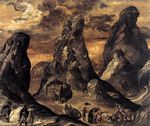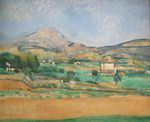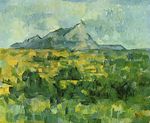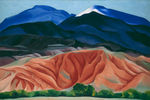The Proposal: Difference between revisions
No edit summary |
No edit summary |
||
| Line 19: | Line 19: | ||
The similarities of this photobook are not only the looks, or feel, but the signs/symbols that they use. The ''‘two mountains''’, that represent the image, the landscape. What does that say? What are the signs and the meaning of does symbols? What kind of language is it? What if I present the symbols in a different way, like a landscape painting or installation. It’s NOT just a sign, icon or image. It becomes more than that and more than a photobook, it starts a conversation. I want to change the context of the book, the context of the symbols and the point of view. I going to question the book, if it’s just and template or could it be more? | The similarities of this photobook are not only the looks, or feel, but the signs/symbols that they use. The ''‘two mountains''’, that represent the image, the landscape. What does that say? What are the signs and the meaning of does symbols? What kind of language is it? What if I present the symbols in a different way, like a landscape painting or installation. It’s NOT just a sign, icon or image. It becomes more than that and more than a photobook, it starts a conversation. I want to change the context of the book, the context of the symbols and the point of view. I going to question the book, if it’s just and template or could it be more? | ||
Still there are some questions to be answered; is this a critic on templates? And who is my audience? In the back of my mind this template concept could be more, because don’t we live in a big template? Is it about our daily relationship with media? or with communication technologies? | |||
[[File:Landscape.JPG]][[File:Landscape.JPG]][[File:Landscape.JPG]][[File:Landscape.JPG]][[File:Landscape.JPG]][[File:Landscape.JPG]][[File:Landscape.JPG]][[File:Landscape.JPG]] | |||
== Research== | |||
As a start for my research working with this image of the template, the symbol; the landscape. I ‘m going to start with some history; landscape art. At specially paintings, because they go a way back. I’m going to grab some examples what I can connect to the digital landscape. | |||
[[file:El_Greco_mount-sinai-1570.jpg|150px|thumb|right|El Greco, Mount Sinai, 1570]] | |||
El Greco, ''Mount Sinai'' | |||
‘''The painting was probably made for the antiquarian Fulvio Orsini, librarian to Cardinal Alessandro Farnese, in whose palace the artist lived from 1570 to 1572. It shows the peaks of Mount Sinai, a place sacred to Judaism and Christianity, of special significance for Eastern Orthodoxy, and revered by Muslims. At the centre is Mount Horeb, where Moses received the tablets of the Ten Commandments from God. On the left is Mount Epistene. The peak on the right is St Catherine's Mount, where the early Christian Martyr Catherine had been buried. The small citadel at the foot of Mount Horeb is the monastery that to this day bears her name.’'' | |||
http://www.wga.hu/frames-e.html?/html/g/greco_el/03/0303grec.html | |||
[[file:Cezanne_-_Ebene_mit_dem_Mont_Sainte_Victoire_1879_1880.jpg|150px|thumb|right|Cézanne, Ebene mit dem Mont Sainte Victoire, 1879-1880]] | |||
[[file:Paul_Cézanne_1904-_1906.jpg|150px|thumb|right|Cézanne, 1904- 1906]] | |||
What I notices when I was researching old landscape paintings, is that I couldn’t find a lots of mountains. The oldest was El Greco, Mount Sinai, which is typical of the romantic cartography of mannerism. Okay what has this to do with the digital landscape? Nothing. | |||
'''An important part of landscape painting is to connect to the nature. They become a part of the nature. But when I got digitalized what happens to the landscape? Can I return it to the nature? Can it be part of the nature again?''' | |||
Than halfway 1800 I found Paul Cézanne who was fascinated by the Mont Sainte-Victoire in southern France. In a lot of his ‘''mountain paintings''’ you see a transition from impressionistic to more cubist style. Cézanne's often repetitive, exploratory brushstrokes are highly characteristic and clearly recognizable. He used planes of colour and small brushstrokes that build up to form complex fields. The paintings convey Cézanne's intense study of his subjects. | |||
[[file:Black_Mesa_Landscape,_New_Mexico-Out_Back_of_Marie’s_II,1930,_oil_on_canvas_by_Georgia_O’Keeffe..jpg|150px|thumb|right|Georgia O’Keeffe. Black Mesa Landscape, New Mexico-Out Back of Marie’s II,1930. ]] | |||
Its maybe just one mountain and not two, but I’m getting closer to the abstract, minimal, digital mountain. | |||
Even with the so called ‘''mother of American Modernism’'' Georgia O’Keeffe painted the nature. | |||
[[file:Mondriaan_Compositie_in_lijn.jpg|150px|thumb|right|Mondriaan, Compositie in lijn, 1916-1917]] | |||
Dutch landscape art became popular in the 17 century, and tended to make smaller paintings for smaller houses. But most of them do not included mountains, simple because there are none mountains in Holland. It gets interesting at the end of 19 century and early 20th centuries, when Mondriaan makes abstract landscapes in the name of modernism. | |||
You actually don’t see a landscape, but this series of ''‘Pier and Ocaan''’ is based on Dutch landscapes during 1916. They also called ‘''plus-minus''’-series, because of the horizontal and vertical crossing each other. | |||
‘''I will try to speak of the beauty of shapes, and I do not mean, as most people would suppose, the shapes of living figures, and their imitations in painting, but I mean straight lines and curves and the shapes made from them, by the lathe, rules or square. They are not beautiful for any particular reason or purpose, as other things are, but are eternally, and by their very nature, beautiful, and give a pleasure of their own quite free from the itch of desire: and in this way colours can give a similar pleasure''’ – In the Philebus of Plato, Socrates. | |||
'''Maybe I’m asking too much of this digital landscape and connect them to greatest painters. But it inspired me to make this image bigger than it is. My focus is to bring it back to nature, to turn the digital to physical, and to make it aesthetic. The history examples are my inspiration to create it.''' | |||
[[File:Landscape.JPG]][[File:Landscape.JPG]][[File:Landscape.JPG]][[File:Landscape.JPG]][[File:Landscape.JPG]][[File:Landscape.JPG]][[File:Landscape.JPG]][[File:Landscape.JPG]] | [[File:Landscape.JPG]][[File:Landscape.JPG]][[File:Landscape.JPG]][[File:Landscape.JPG]][[File:Landscape.JPG]][[File:Landscape.JPG]][[File:Landscape.JPG]][[File:Landscape.JPG]] | ||
Revision as of 19:51, 18 February 2015
I want to focus on the so called ‘template book’, a better name will come. Everyone can make a photobook, specialty online. There are many companies with photo service, and software, to make your own photobook, and in the end to order your creation. Also they provided you with a template to give you an idea for division of your photos. I want to print the template what the companies provided for you. So I print the different kind of divisions in a physical book. First I have to make screenshots of the template, otherwise the pages become blank when you order it. After the screenshots is place them at the exact place of the template example. The book consist of images of the template.
Some companies use the same software so they have the same templates. (Like Kruidvat, Lidl, Cewe, Pixum, Bol) I try to find different templates, so I order at:
- Kruidvat
- Hema
- LuLu
- Albelli
- Fotofabriek
- MyPhotobook
The similarities of this photobook are not only the looks, or feel, but the signs/symbols that they use. The ‘two mountains’, that represent the image, the landscape. What does that say? What are the signs and the meaning of does symbols? What kind of language is it? What if I present the symbols in a different way, like a landscape painting or installation. It’s NOT just a sign, icon or image. It becomes more than that and more than a photobook, it starts a conversation. I want to change the context of the book, the context of the symbols and the point of view. I going to question the book, if it’s just and template or could it be more?
Still there are some questions to be answered; is this a critic on templates? And who is my audience? In the back of my mind this template concept could be more, because don’t we live in a big template? Is it about our daily relationship with media? or with communication technologies?
Research
As a start for my research working with this image of the template, the symbol; the landscape. I ‘m going to start with some history; landscape art. At specially paintings, because they go a way back. I’m going to grab some examples what I can connect to the digital landscape.
El Greco, Mount Sinai
‘The painting was probably made for the antiquarian Fulvio Orsini, librarian to Cardinal Alessandro Farnese, in whose palace the artist lived from 1570 to 1572. It shows the peaks of Mount Sinai, a place sacred to Judaism and Christianity, of special significance for Eastern Orthodoxy, and revered by Muslims. At the centre is Mount Horeb, where Moses received the tablets of the Ten Commandments from God. On the left is Mount Epistene. The peak on the right is St Catherine's Mount, where the early Christian Martyr Catherine had been buried. The small citadel at the foot of Mount Horeb is the monastery that to this day bears her name.’ http://www.wga.hu/frames-e.html?/html/g/greco_el/03/0303grec.html
What I notices when I was researching old landscape paintings, is that I couldn’t find a lots of mountains. The oldest was El Greco, Mount Sinai, which is typical of the romantic cartography of mannerism. Okay what has this to do with the digital landscape? Nothing.
An important part of landscape painting is to connect to the nature. They become a part of the nature. But when I got digitalized what happens to the landscape? Can I return it to the nature? Can it be part of the nature again?
Than halfway 1800 I found Paul Cézanne who was fascinated by the Mont Sainte-Victoire in southern France. In a lot of his ‘mountain paintings’ you see a transition from impressionistic to more cubist style. Cézanne's often repetitive, exploratory brushstrokes are highly characteristic and clearly recognizable. He used planes of colour and small brushstrokes that build up to form complex fields. The paintings convey Cézanne's intense study of his subjects.
Its maybe just one mountain and not two, but I’m getting closer to the abstract, minimal, digital mountain.
Even with the so called ‘mother of American Modernism’ Georgia O’Keeffe painted the nature.
Dutch landscape art became popular in the 17 century, and tended to make smaller paintings for smaller houses. But most of them do not included mountains, simple because there are none mountains in Holland. It gets interesting at the end of 19 century and early 20th centuries, when Mondriaan makes abstract landscapes in the name of modernism.
You actually don’t see a landscape, but this series of ‘Pier and Ocaan’ is based on Dutch landscapes during 1916. They also called ‘plus-minus’-series, because of the horizontal and vertical crossing each other.
‘I will try to speak of the beauty of shapes, and I do not mean, as most people would suppose, the shapes of living figures, and their imitations in painting, but I mean straight lines and curves and the shapes made from them, by the lathe, rules or square. They are not beautiful for any particular reason or purpose, as other things are, but are eternally, and by their very nature, beautiful, and give a pleasure of their own quite free from the itch of desire: and in this way colours can give a similar pleasure’ – In the Philebus of Plato, Socrates.
Maybe I’m asking too much of this digital landscape and connect them to greatest painters. But it inspired me to make this image bigger than it is. My focus is to bring it back to nature, to turn the digital to physical, and to make it aesthetic. The history examples are my inspiration to create it.





